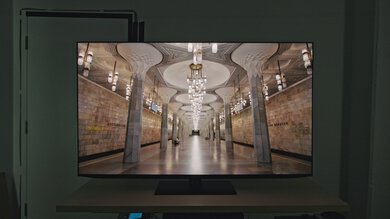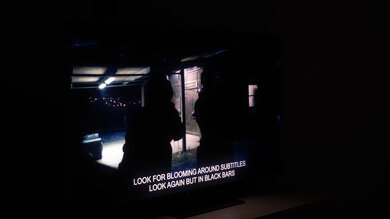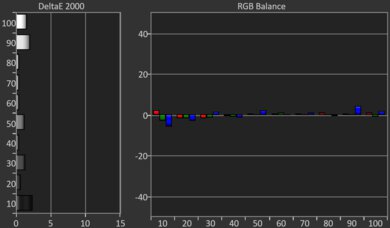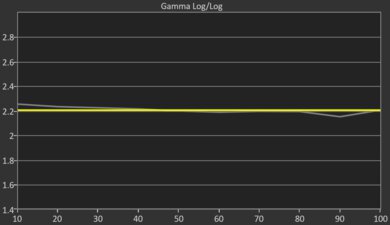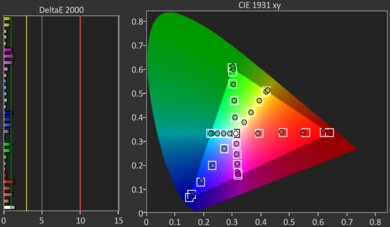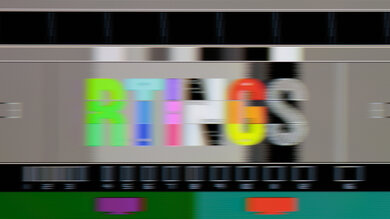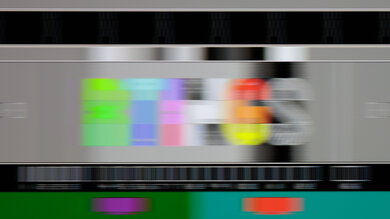The Sharp AQUOS XLED FV1 is part of Sharp's premium AQUOS line-up. It uses Deep Chroma QD technology that is designed to provide the brightness of an LCD TV with contrast close to that of an OLED. It includes Dolby Vision IQ to adjust the picture brightness based on the amount of ambient light in a room and has over 2000 dimming zones that are meant to precisely control the backlight for effective local dimming. The TV has Sharp's ARSS+ speaker system, which has 11 speakers built-in with a maximum output of 85W, and it supports both DTS and Dolby Digital passthrough, as well as Dolby Atmos. It's only available in 65-inch and 75-inch sizes.
Our Verdict
The Sharp AQUOS XLED is good for a variety of usages. It looks good in reference conditions thanks to its great black levels, vibrant colors, and great HDR brightness. However, colors are very inaccurate out of the box, which will bother people who want an accurate image. Even though it struggles with direct reflections, it overcomes glare from indirect light sources in very bright rooms, and image quality is barely affected by light. It has modern gaming features that make it a good pairing with modern consoles, but its relatively high input lag holds back its performance for competitive titles. Unfortunately, the TV has a very narrow viewing angle, so it's not suitable for wide seating arrangements.
Black levels and colors are barely affected in a bright room.
Excellent SDR brightness means it easily handles glare from indirect lights.
Great HDR brightness means highlights pop out.
Blacks are deep and bold with minimal haloing around highlights and subtitles.
Distracting direct mirror-like reflections.
Low-resolution content is soft due to poor upscaling.
Image is degraded from the sides due to its narrow viewing angle.
Very inaccurate colors due to poor pre-calibration accuracy.
The Sharp AQUOS XLED is good for a home theater. The TV has great black levels overall, thanks to its effective local dimming, so blacks are very deep, and there's only some minor haloing around subtitles and highlights. Highlights really pop out in HDR movies and shows, so HDR content is impactful. Colors are rich and vibrant on this model, but they're incredibly inaccurate out of the box, so this TV requires calibration if you care at all about the filmmaker's intent. The TV does a very good job cleaning up artifacts in low-bitrate content, but it has very poor upscaling capabilities, so stick to 4k sources when possible.
Removes judder from all sources.
Excellent PQ EOTF tracking.
Great HDR brightness means highlights pop out.
Colors are vibrant and punchy.
Blacks are deep and bold with minimal haloing around highlights and subtitles.
Low-resolution content is soft due to poor upscaling.
Very inaccurate colors due to poor pre-calibration accuracy.
The Sharp AQUOS XLED is very good for a bright room. The TV has excellent SDR brightness, so it overcomes glare from indirect light sources with ease. However, direct reflections are very visible on the screen, especially during dark scenes, which is distracting. Fortunately, the vibrancy of colors and the depth of blacks are barely affected by light, so you don't have to worry about the quality of the image degrading when you flip your lights on.
Black levels and colors are barely affected in a bright room.
Excellent SDR brightness means it easily handles glare from indirect lights.
Distracting direct mirror-like reflections.
The Sharp AQUOS XLED is good for watching sports. Its excellent SDR brightness means you can watch the game in a bright room and reflections aren't an issue, as long as you don't have a light or window directly facing the screen. Colors are very vibrant on this TV, but they're noticeably inaccurate, so you might find that your favorite team's jersey looks a bit off. Artifacts in low-quality feeds are cleaned up well, but the TV's poor upscaling means low-resolution content looks soft and lacks detail, so it's best to stick with the highest resolution sources possible. Unfortunately, this model has a very narrow viewing angle, so image quality is degraded even at a slight angle, making it a poor choice for wide seating arrangements.
Does a very good job smoothing out artifacts in low-quality content.
Excellent SDR brightness means it easily handles glare from indirect lights.
Colors are vibrant and punchy.
Distracting direct mirror-like reflections.
Low-resolution content is soft due to poor upscaling.
Image is degraded from the sides due to its narrow viewing angle.
Very inaccurate colors due to poor pre-calibration accuracy.
The Sharp AQUOS XLED is good for gaming. It has a nice combination of deep blacks, vibrant colors, and great HDR brightness, so your games look punchy and impressive. The TV has HDMI 2.1 bandwidth for 4k @ 120Hz gaming. It also supports VRR, but there's screen tearing with frame rates above 105fps, so it has a narrower range than most competing models. The TV's input lag is low enough that you don't feel a delay with your inputs, but it's nearly double the amount of lag you get from most other TVs, which holds back its performance for competitive gamers playing games like Call of Duty. Fortunately, the TV has pretty fast pixel response times for an LED, so motion blur is kept to a minimum.
HDMI 2.1 bandwidth, 4k @ 120Hz, and VRR.
Colors are vibrant and punchy.
Blacks are deep and bold with minimal haloing around highlights and subtitles.
Very inaccurate colors due to poor pre-calibration accuracy.
VRR issues with frame rates above 105 fps.
Doesn't support chroma 4:4:4 in 120Hz.
Higher input lag than competing models means it's not as good for competitive titles.
The Sharp AQUOS XLED has amazing brightness overall. The TV's SDR brightness is excellent, and it easily overcomes glare from indirect lighting in a bright room. The TV also provides an impactful HDR experience, with highlights and bright scenes that really pop out.
Excellent SDR brightness means it easily handles glare from indirect lights.
Great HDR brightness means highlights pop out.
The Sharp AQUOS XLED has great black levels. The TV's contrast is excellent with local dimming enabled, providing very deep blacks, and its good lighting zone precision keeps haloing around subtitles and highlights to a minimum. Furthermore, blacks are uniform across the screen, so purely dark scenes look great.
Blacks are deep and bold with minimal haloing around highlights and subtitles.
The Sharp AQUOS XLED has only satisfactory colors overall, but that's mostly due to how poor color accuracy is out of the box. In both SDR and HDR, colors are very inaccurate, so even casual viewers may find certain colors looking a bit off. If you care about accurate colors, this TV requires a calibration, and even then, you can't calibrate it to be as accurate as most other TVs. Fortunately, colors are vibrant and punchy in both SDR and HDR, so the image certainly doesn't look dull.
Colors are vibrant and punchy.
Very inaccurate colors due to poor pre-calibration accuracy.
Note: We're in the process of improving our tests related to image processing, but this score should give you a general idea of how a TV performs overall with its image processing capabilities.
The Sharp AQUOS XLED has just okay processing. It does an excellent job mostly displaying HDR content at the proper brightness level due to its excellent PQ EOTF tracking. Artifacts in heavily compressed content are cleaned up well due to the TV's very good low-quality content smoothing, but its poor upscaling means low-resolution streams look soft and lack detail. The TV has alright HDR gradient handling overall, but there's visible banding in complex grays, and there's some minor banding in some other gradients.
Excellent PQ EOTF tracking.
Does a very good job smoothing out artifacts in low-quality content.
Low-resolution content is soft due to poor upscaling.
The Sharp AQUOS XLED has decent responsiveness in its dedicated gaming mode. The TV has HDMI 2.1 bandwidth on two ports and supports 4k @ 120Hz gaming. It also supports VRR, but there's screen tearing with frame rates above 105fps, which gives it a narrower VRR range than almost any other 120Hz TV. It also has higher input lag than most competing models, so even though gaming feels responsive, you're at a bit of a disadvantage in competitive titles. Fortunately, the TV has fast pixel transitions for an LED model, so motion blur is kept to a minimum.
HDMI 2.1 bandwidth, 4k @ 120Hz, and VRR.
VRR issues with frame rates above 105 fps.
Doesn't support chroma 4:4:4 in 120Hz.
Higher input lag than competing models means it's not as good for competitive titles.
We're in the process of fixing the way we evaluate a TV's overall motion handling. This section is currently broken, and the score isn't indicative of how well a TV handles motion overall.
Performance Usages
Changelog
- Updated Sep 24, 2025: Converted to Test Bench 2.0.1. We did this to fix an issue with our scoring in the Supported Resolutions section, since TVs with a refresh rate higher than 144Hz were being penalized for not supporting 144Hz.
-
Updated Sep 24, 2025:
We wrote text for the new tests and rewrote text throughout the review after updating pre-existing tests and scores for Test Bench 2.0.
- Updated Sep 24, 2025: We converted the review to Test Bench 2.0. With this new methodology, we've added new tests to expand the scope of our testing, adjusted our scoring to better align with current market conditions, and added performance usages that group related tests together to give more insight into specific aspects of a TV's performance. You can find a full list of changes in the TV 2.0 changelog.
- Updated Aug 13, 2024: Mentioned the newly reviewed LG QNED90T in the Pre-Calibration section of this review.
Check Price
Differences Between Sizes And Variants
We bought and tested the 65-inch Sharp AQUOS XLED (4T-C65FV1U), but our results are also valid for the 75-inch model.
| Size | US Model | International Model Code | Dimming Zones |
|---|---|---|---|
| 65" | 4T-C65FV1U | 4T-C65FV1X | 2160 |
| 75" | 4T-C75FV1U | 4T-C75FV1X | 2304 |
Our unit was manufactured in China in 2023.
Popular TV Comparisons
The Sharp AQUOS XLED is a good TV overall, but it's held back by its issues with VRR, lack of chroma 4:4:4 @ 120Hz support, narrow viewing angle, bad pre-calibration accuracy, small selection of sizes, and expensive price tag. The FV1 isn't anything special, and you can get similar performance from the cheaper Sony X90L/X90CL or better overall performance from the TCL QM8K.
For more options, check out our recommendations for the best QLED TVs and the best 4k TVs, or if you need something smaller, check out our article on the best 55-inch TVs.
The Sharp AQUOS XLED FV1 and the Sony X90L/X90CL are similar TVs, each with their own strengths. The Sharp has better contrast and black uniformity, so it looks better in a dark room, and highlights in HDR content stand out a bit more on it due to its better HDR peak brightness. However, the Sony TV has better processing, so it upscales low-resolution content much better, has less banding in HDR content, and has lower input lag. The Sony also has much better pre-calibration accuracy, so you don't have to get it calibrated if you care about color accuracy.
The Sharp AQUOS XLED FV1 and the Sharp AQUOS FS1 OLED are better than each other in different ways. The FS1 is better suited for a dark room due to its nearly infinite contrast ratio and perfect black uniformity, and it's the better option for a group setting due to its much wider viewing angle. The FS1 also has a quicker response time, so there is less blur behind quick-moving objects. However, the FV1 is better suited for a well-lit room due to its much higher SDR brightness, so it can overcome more glare, and its higher HDR brightness makes highlights stand out more in HDR content.
The LG C3 OLED is better than the Sharp AQUOS XLED FV1. The LG has a quicker response time for less blur behind quick motion, and its lower input lag provides a more responsive gaming or desktop experience. The LG is also better suited for watching TV as a group due to its much wider viewing angle, and it's also better suited for a dark room due to its higher contrast ratio and better black uniformity.
The LG G3 OLED is better than the Sharp AQUOS XLED FV1. The LG G3 has deeper blacks due to its nearly infinite contrast ratio and perfect black uniformity, so it looks better in a dark room. The LG also has a much wider viewing angle, so it's better suited for watching TV as a group since no one will have to watch a degraded image. When it comes to response time, the LG is much faster, so there is less blur behind quick-moving objects, and it has a lower input lag for a more responsive gaming experience.

We buy and test dozens of TVs yearly, taking an objective, data-driven approach to deliver results you can trust. Our testing process is complex, with hundreds of individual tests that take over a week to complete. Most of our tests are done with specially designed test patterns that mimic real content, but we also use the same sources you have at home to ensure our results match the real-world experience. We use two main tools for our testing: a Colorimetry Research CR-100 colorimeter and a CR-250 spectroradiometer.
Test Results

The Sharp AQUOS XLED has great HDR brightness. Highlights really pop out during dark scenes, and the TV gets bright enough for very bright specular highlights to stand out in well-lit scenes.
These measurements are after calibrating the HDR white point with the following settings:
- HDR Picture Mode: Movie HDR
- Backlight: 100
- Brightness: 50
- Contrast: 50
- Saturation: 50
- Local Dimming: High
- Color Temperature: Warm
- Gamma: Middle
- Adaptive Luma Control: Off
- Color Space: Auto
The TV has very good HDR brightness in Game Mode, but it's visibly dimmer than Movie Mode.
These measurements are after calibrating the HDR white point with the following settings:
- HDR Picture Mode: Game HDR
- Backlight: 100
- Brightness: 50
- Contrast: 50
- Saturation: 50
- Local Dimming: High
- Game Mode: On
- Color Temperature: Warm
- Gamma: Middle
- Adaptive Luma Control: Off
- Color Space: Auto
The Sharp AQUOS XLED has amazing SDR brightness. It's bright enough to easily overcome glare from indirect light sources in well-lit rooms.
These measurements are after calibration with the following settings:
- Picture Mode: Movie
- Backlight: 100
- Brightness: 50
- Contrast: 45
- Saturation: 50
- Local Dimming: High
- Color Temperature: Warm
- Gamma: Middle
- Color space: Auto
The Sharp AQUOS XLED TV has excellent contrast with local dimming enabled. Blacks are deep when viewed in a dark room, and they stay that way when highlights are on screen. With local dimming disabled, the TV's contrast is mediocre, and blacks appear raised and washed out when highlights are on screen.
The TV has good overall lighting zone transitions, but it does struggle with very fast-moving content. The leading edge of quick-moving objects is visibly dimmer, and there's noticeable haloing.
The TV's SDR color volume is good. Like almost any TV from the past few years, it fully covers the commonly used BT.709 color space. It also has good coverage of the DCI-P3 color space, although it can't quite fully display bright greens, yellows, and oranges. The TV's coverage of the wider BT.2020 space is decent, but it struggles to show close to the full range of colors available in that space.
| Volume ΔE³ | DCI-P3 Coverage |
BT.2020 Coverage |
|---|---|---|
| L10 | 93.90% | 76.13% |
| L20 | 91.69% | 77.10% |
| L30 | 93.34% | 77.64% |
| L40 | 89.37% | 77.32% |
| L50 | 86.89% | 76.63% |
| L60 | 85.24% | 75.45% |
| L70 | 84.62% | 70.06% |
| L80 | 83.90% | 67.80% |
| L90 | 83.73% | 68.12% |
| L100 | 86.52% | 72.32% |
| Total | 86.32% | 72.91% |
The Sharp AQUOS XLED has excellent HDR color volume. The TV displays a wide range of colors at high luminance levels, and dark saturated colors are displayed well due to its fantastic contrast.
The Sharp AQUOS XLED TV has bad SDR pre-calibration accuracy. The color temperature is too cool, and the white balance is very off, with noticeable accuracy errors throughout mid-grays and whites and an overrepresentation of reds and blues. Gamma is also off, with dark scenes being too dark and brighter scenes being too bright. Colors are very inaccurate across the board, with yellows, cyans, and whites being the most off.
If you want a TV with much better pre-calibration SDR accuracy, take a look at the LG QNED90T.
The TV has incredible SDR accuracy after calibration. White balance is only slightly off now, and gamma is much closer to the 2.2 target, with only dark scenes being slightly too dark and some bright scenes being slightly too bright. Color temperature is much closer to the D65 white point and color accuracy is much better across the board.
See our full calibration settings.
The TV has inadequate HDR color accuracy before calibration. There's not enough red and too much blue in lighter grays, which contributes to the TV's significantly too cold color temperature. Overall color accuracy is inadequate, with significant mapping errors throughout, so colors in any form of HDR content are very inaccurate.
After calibration, the TV has decent HDR color accuracy. The white balance is now satisfactory, but it's still off. The color temperature is much closer to 6,500K, but now it's a bit too warm. The accuracy of colors has improved overall, but there's still mapping errors that will bother anyone who wants the most accurate image.
The Sharp AQUOS XLED TV has excellent PQ EOTF tracking. Blacks and some midtones are slightly brighter than intended, and some shadows, midtones, and highlights are a bit darker than intended, but the TV displays HDR content very close to the content creator's intent. There's a roll-off near the TV's peak brightness to maintain some details in very bright highlights.
Unfortunately, the TV has poor sharpness processing with low-resolution and low-bitrate content. The image isn't very clear or sharp, finer details are mostly lost, and small hard-coded text is hard to make out.
Sharpness processing was calibrated with no over-sharpening for low-resolution or low-bitrate content with the following settings:
- Sharpness: 10
- AISR: Middle
The Sharp AQUOS XLED has okay HDR gradient handling. There's visible banding in darker shades of green and blue, with very noticeable banding across all grays. Other colors have minimal banding.
The Sharp AQUOS XLED has decently low input lag when set to Game Mode. Although it's not as low as many other TVs on the market, it's still low enough to provide a responsive gaming experience at 120Hz. However, the TV's input lag is especially high at 60Hz.
The TV supports all common resolutions up to 4k @ 120Hz on two of its four HDMI ports. It also displays 1080p and 4K @ 60Hz @ 4:4:4, which is essential for clear text from a PC. Unfortunately, the TV can't properly display 4:4:4 in both 1080p and 4K @ 120Hz.
The TV supports all three VRR formats, so it has great compatibility regardless of the source. Unfortunately, we encountered an unusual tearing effect near the bottom of the screen with frame rates above 105fps in both 1080p and 4K, which you can see here.
Due to the aforementioned issue, the effective VRR range is 20Hz-105Hz, since anything above that causes screen-tearing.
The TV's CAD at its maximum refresh rate of 120Hz is decent. Pixel transitions are slower when exiting and entering a dark state, which leads to some black smearing. There's also some overshooting, so there's some inverse ghosting. However, pixel response times are pretty fast for an LED model, so even though you don't get the crystal clear motion that an OLED provides, there's minimal blur behind fast motion.
The TV's CAD at its maximum refresh rate of 120Hz is decent. Pixel transitions are slower when exiting and entering a dark state, which leads to some black smearing. There's also some overshooting, so there's some inverse ghosting. However, pixel response times are pretty fast for an LED model, so even though you don't get the crystal clear motion that an OLED provides, there's minimal blur behind fast motion.
The TV's CAD at 60Hz is decent. Like at 120Hz, pixel transitions are slower when exiting and entering a dark state, which causes some black smearing. There's also some overshooting, which leads to inverse ghosting, but it's subtle. There's some persistence blur at 60Hz, so motion isn't as crisp as it is at 120Hz, but motion blur is kept to a minimum.
As long as you're using HDMI ports 3 or 4, the TV is compatible with almost everything the Xbox Series X|S offers. Unfortunately, the TV can't do 4k @ 120Hz with Dolby Vision enabled, so if you want to play in Dolby Vision, you're limited to 60Hz. It also doesn't support 1440p @ 120Hz.
Due to the TV's quick response time, there's noticeable stutter when watching movies or TV shows, and it's most noticeable in slow panning shots.
The TV automatically removes judder from all sources with no additional settings required.
The Sharp AQUOS XLED has a great response time for minimal motion blur when watching content. Unfortunately, the response time is slower when coming out of dark states, so there's some noticeable black smearing in dark transitions. Still, you don't notice a ton of added blur when watching content on this TV.
The Sharp AQUOS XLED uses pulse width modulation (PWM) to dim its backlight. It flickers at a relatively low 320Hz in all picture modes and at all brightness levels. This is low enough to be noticeable to those who are sensitive to it, especially since it doesn't flicker in time with the TV's refresh rate.
The TV doesn't have an optional backlight strobing feature, commonly known as black frame insertion (BFI), to help reduce persistence blur.
The TV has optional motion interpolation to help smooth out low frame rate content, but it doesn't work very well. Even slower-moving scenes have noticeable artifacts present, and it struggles so much with faster scenes that it has a screen-tearing type effect with haloing around characters.
The Sharp AQUOS XLED has unremarkable direct reflection handling. The intensity of direct reflections are reduced a bit, but light sources like a lamp or window opposite your screen are still very noticeable.
There's only some very minor black level raise in a room with ambient lighting, so you still get deep blacks with your lights turned on.
The amount of total reflected light is good. The TV handles glare well from indirect lighting, but direct reflections are quite distracting, especially during dark scenes. Fortunately, there's no artifacts like rainbow smearing or light banding.
The TV's perceived color volume in a bright room is excellent. Colors barely lose any saturation when they're exposed to light, so you still get punchy colors in a well-lit room.
The TV has an inadequate viewing angle. The image is dimmer, faded, and washed out as you move off-center, so it's not a good choice for a wide seating arrangement, as anyone sitting off to the sides sees a severely degraded image.
The TV has okay gray uniformity. There's some slight vignetting in the corners, and there's some visible dirty screen effect towards the center of the screen, which is most noticeable when watching sports with large areas of the same color, like hockey and football.
The TV uses a BGR (blue-green-red) subpixel layout. This doesn't cause issues with normal content, but it causes text clarity issues when you use the TV as a PC monitor. However, there are easy workarounds for these issues that you can read about here.
The TV uses quantum dots to achieve high color peaks with excellent separation between blues, greens, and reds. This gives the TV great color purity and allows it to display a very wide color gamut.
The TV has HDMI 2.1 bandwidth on HDMI ports 3 and 4. HDMI 3 is also the eARC port, so if you have a soundbar plugged into it, you're only left with one port capable of HDMI 2.1 bandwidth.
The TV supports eARC, which lets you pass high-quality, uncompressed audio to a compatible receiver or soundbar through an HDMI cable. It supports most major audio formats, so you don't have to worry about compatibility with external sources most of the time. Unfortunately, it doesn't support LPCM 7.1 and is limited to LPCM 2.0.
The back of the TV is bulky and is made entirely of plastic. Some of the inputs face the sides, and they aren't set into the TV, so they're accessible when it's wall-mounted. There's a tie on the back of the TV as well as a channel on the back of the stand that can be used to help with cable management.
The TV has a nice remote with dedicated buttons for the most popular streaming services. It also has a physical number pad for those who need buttons to change channels. The remote has a built-in microphone for voice commands, but we couldn't get it to work properly. Google Assistant activates when pressing the microphone button, but the remote won't pick up any voices. We don't know for sure if the issue is isolated to our remote or not.
The TV has an alright frequency response. Dialogue sounds clear enough, but the TV doesn't get very loud and lacks meaningful bass. You will want to pair it with a decent soundbar or surround sound system if you want proper bass and louder overall volume.

